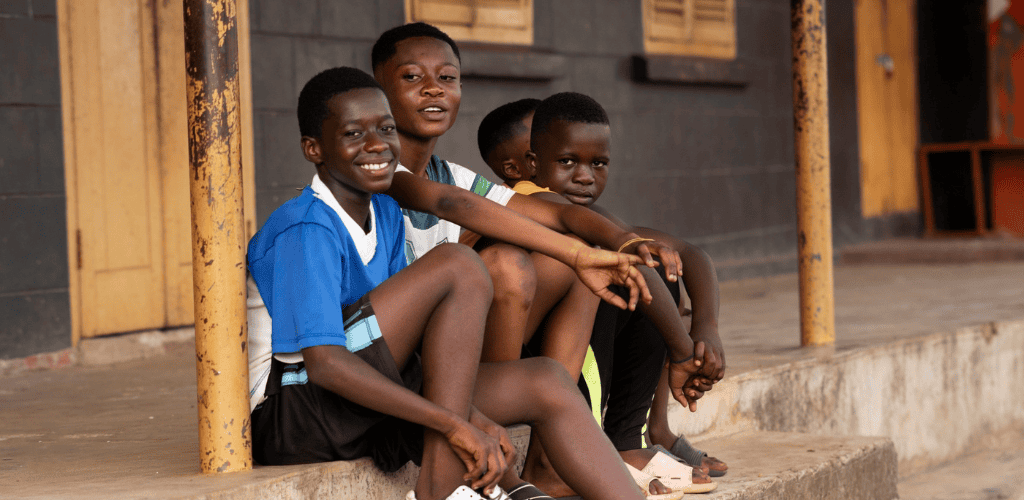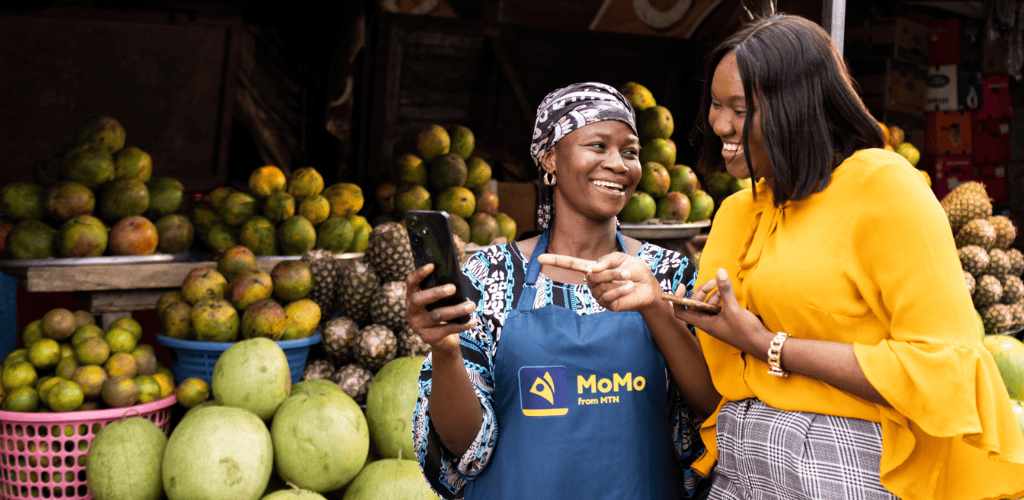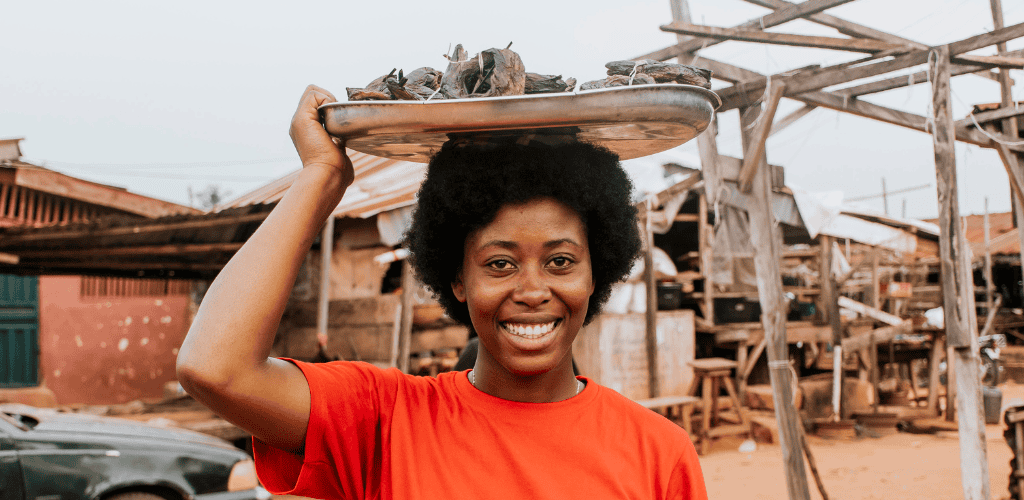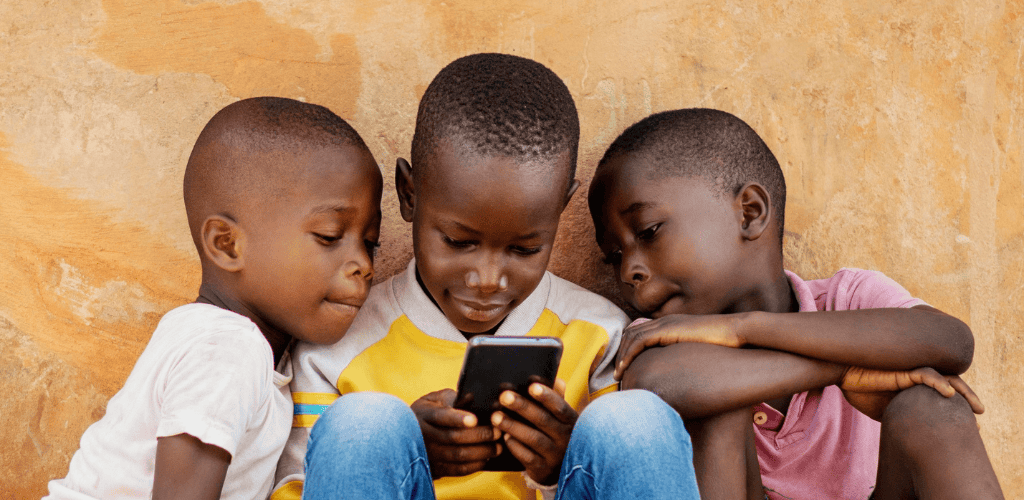Ghana faces several social issues that affect its socio-economic development. This roundup presents detailed data and analyses of various critical areas, such as poverty levels and divorce rates, to offer insights into the country’s challenges.
Key takeaways
Before we deep-dive, here are our top takeaways:
- The poverty rate increased by 4% in 2023 compared to 2022.
- Over one million Ghanaians are predicted to face hunger between June and August 2024.
- There are about 100,000 children between the ages of 6 to 14 years with disabilities as of 2023.
- The national rate of early marriage has decreased to 4% from 35% in the 1990s.
- Almost half of the Ghanaian population, approximately 15.1 million, experienced food insecurity or hunger in the first quarter of 2022.
- Teenage pregnancy is more common in girls with no education.
- Men spend more years in marriage before divorce than women.
Poverty statistics in Ghana
1. The number of people who fall below the international poverty line was approximately 31.4% in 2023. (World Bank)
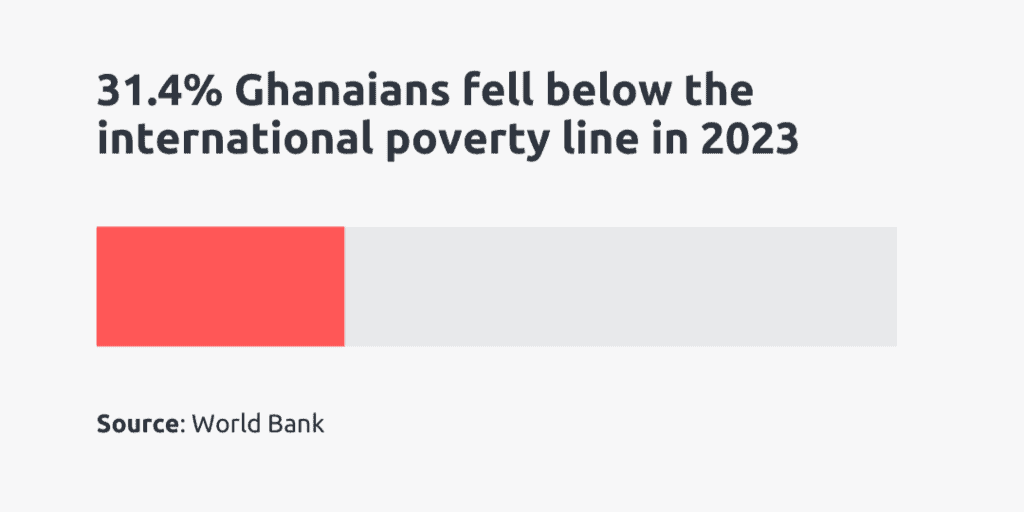 Due to the weak economic growth resulting from debt restructuring, inflation, and other financial factors, the poverty rate increased by 4% in 2023 compared to 2022.
Due to the weak economic growth resulting from debt restructuring, inflation, and other financial factors, the poverty rate increased by 4% in 2023 compared to 2022.
2. Approximately 2.99 million Ghanaians are extremely poor. (Statista)
In 2023, about 2.99 million Ghanaians struggled to meet their basic needs of food, water, and shelter.
3. More men lived in extreme poverty than women in 2023. (Statista)
About 1.5 million men live below the international poverty line or are said to be extremely poor in Ghana, and an almost equal number, 1.44 million women, live below the international poverty line or are said to be extremely poor.
4. The poverty rate is higher in rural areas than in urban areas. (Statista)
Poverty levels in urban areas such as Accra are generally better than in rural areas due to relatively improved economic opportunities and services.
5. The World Bank’s poverty line is adopted at $2.15. (World Bank)
The World Bank updated the extreme poverty line from $1.90 per day (approximately GHS 30) in 2019 to $2.15 (approximately GHS 33) per day in 2022.
6. Nabdam District, situated in the Upper East Region, recorded the highest poverty rate, making it the poorest district in Ghana in 2021. (Graphic Online)

The criteria used to measure the poverty rate in the regions were living conditions, education, health, and employment. The poverty rate in Nabdam District was 68.6%, higher than the national rate of 24.3%.
Hunger Statistics in Ghana
7. In 2022, households with dependent children and older people were more food insecure than those without dependents. (Ghana Statistical Service)
The frequency of food insecurity or hunger in households with no dependents is 34.0%. In comparison, those with only elderly dependents are 37.7%, those with child dependents only are 43.5%, and those with children and elderly dependents are 45.2%.
8. In 2022, food insecurity or hunger was more common in households where the heads had no formal education. (Ghana Statistical Service)
The prevalence of food insecurity in households with heads with formal education is about 7% less (42.1%) than in households with heads that have no formal education (49.1%).
9. The North East Region recorded the highest food insecurity in Ghana in the first and second quarter of 2022. (Ghana Statistical Service)
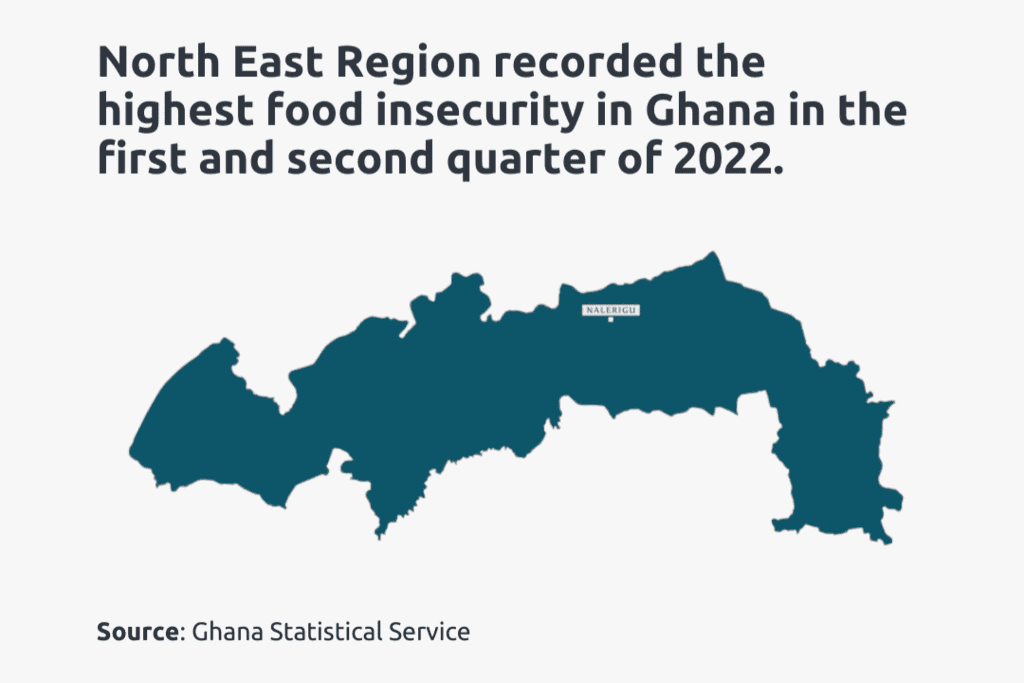
Hunger or food insecurity was 32.9%, the highest rate among all regions in Ghana and higher than the national rate of 12.3%.
10. The Eastern Region recorded the lowest number of food insecurity in 2022. (Ghana Statistical Service)
Hunger or food insecurity is 7.3%, which is comparatively the lowest among all the regions in Ghana and also lower than the national rate of 12.3%.
11. Almost half of the Ghanaian population is food insecure or hungry. (MyJoyOnline)
The Ghana Income and Expenditure Survey for 2022 reported that about 15.1 million individuals, representing 49%, were hungry or food insecure in the first quarter of 2022.
12. There was a reduction in hunger or food insecurity in the second quarter of 2022. (Ghana Statistical Service)
Ghana Statistical Service Service’s quarterly food insecurity report indicated a decline in hunger or food insecurity from 49.1% in the first quarter of 2022 to 42.1%, representing about 13 million people in the second quarter of 2022.
13. Ghana places 62nd position in the 2023 Global Hunger Index. (Global Hunger Index)

According to the Global Hunger Index, Ghana is 62nd with a score of 13.7 among 125 countries worldwide, using undernourishment, child wasting, child stunting, and child mortality as indicators.
14. More than 1 million Ghanaians are predicted to be food insecure or hungry between June-August 2024. (3News)
According to the World Food Programme (WFP) report, over one million Ghanaians will likely face hunger or food insecurity between June and August 2024. This is predicted to be caused by high food prices and inflation, among other factors.
15. Food insecurity or hunger is higher in rural areas than in urban areas. (Ghana Statistical Service)
Food Security or hunger in rural areas was 60.3% and 55.3% in the first and second quarters of 2022, respectively, while in urban centres, it was 42.7% and 33.5% in both quarters.
16. Approximately 6.4 million people in Ghana are both food insecure and multidimensionally poor. (Ghana Statistical Service)
6.4 million people, representing 20.8% of the population, were hungry and poor in the first and second quarters of 2022.
Disability Statistics in Ghana
17. 8% of the Ghanaian population have a disability. (Ghana Statistical Service)
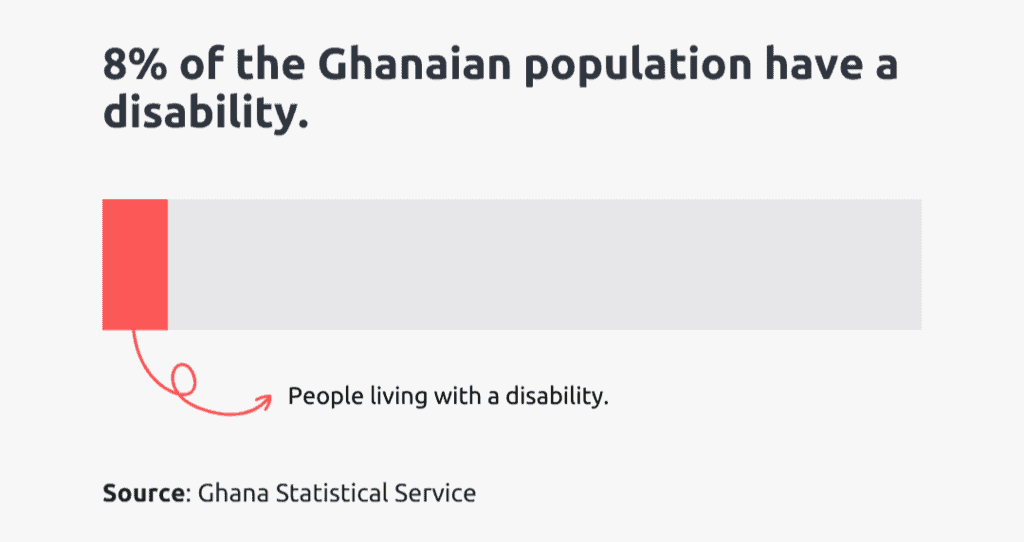
The 2022 population and housing census by the Ghana Statistical Service (GSS) indicates that about 8% of the Ghanaian population has a disability.
18. Disability is more common in females than in males in Ghana in 2021. (Ghana Statistical Service)
Ghana Statistical Service reported that 8.8% of females in Ghana have disabilities than males, who are 6.7%.
19. Rural areas record a higher number of disabilities compared to their urban counterparts in Ghana in 2021. (Ghana Statistical Service)
Ghana Statistical Service reported that disabilities in rural areas are more, representing 9.5%, compared to urban areas, which is 6.5%.
20. Low vision or blindness is the most common disability in Ghana in 2021. (Ghana Statistical Service)
Ghana Statistical Service reported that blindness or low vision is the most common disability in Ghana, affecting about 4% of the population.
21. Speech impairment or communication difficulties are recorded as the disability with the lowest frequency in Ghana in 2021. (Ghana Statistical Service)
Ghana Statistical Service reported that communication difficulties or speech impairment are the least common, affecting 1% of the Ghanaian population.
22. There was a 5% increase in persons with disabilities from 2010 to 2022. (BFT)

Ghana Statistical Service (GSS) reported that there was an increase in persons with disability from 3% in 2010 to 8% in 2022.
23. 100,000 children have a disability in Ghana in 2023. (GhanaWeb)
100,000 Ghanaian children between the ages of 6 years to 14 years have a form of disability in 2023.
24. 16,000 children with disabilities in Ghana are not in school in 2023. (GhanaWeb)
As of 2023, approximately 16,000 children with disabilities in Ghana are not attending school, highlighting significant gaps in the educational system’s accessibility. These children of school-going ages are left at home with no means of attending school.
25. There were more people with disabilities in rural areas than in urban centres in 2021. (Mastercard Foundation)
10% of people in rural areas live with disabilities compared to 6.5% of people in urban centres.
26. Ashanti Region has the highest number of persons with disability. (Ghana Statistical Service)
Ghana Statistical Service reported in the 2021 Population and Housing Census (PHC) general report that the Ashanti Region recorded 17.3 persons five years and above having some form of disability, making it the highest in Ghana.
Divorce Statistics in Ghana
27. There were 553,065 divorced persons in Ghana in 2021. (Ghana Statistical Service)
According to the 2021 Population and Housing Census (PHC), there were 553,065 divorced people living in Ghana.
28. 362,233 females got a divorce in Ghana in 2021. (Ghana Statistical Service)
According to the 2021 Population and Housing Census (PHC), it was reported that 362,233 females, representing 65.5%, had their marriages dissolved.
29. 190,832 males got a divorce in Ghana in 2021. (Ghana Statistical Service)
According to the 2021 Population and Housing Census (PHC), it was reported that 190,832 males, representing 34.5%, had their marriages dissolved.
30. Men spend more years in marriage before divorce. (Research Gate)

Men spend an average duration of 16.63 years in marriage before divorce compared to women, who spend an average duration of 9.68 years in marriage before divorce in 2021.
31. Married women between the ages of 15-19 have not divorced. (DHS, 2022)
A report on the Demographic and Health Survey in 2022 indicated that none of the 2682 married respondents between the ages of 15 and 19 were divorced.
32. 0.2% of married women between 20-24 years are divorced. (DHS, 2022)
The report on the Demographic and Health Survey in 2022 indicated that 0.2% out of 2695 married couples between the ages of 20 and 24 were divorced, compared to 0.3% of men.
33. 1% of women between the ages of 25-29 are divorced. (DHS, 2022)
A report on the Demographic and Health Survey in 2022 indicated that 1% of 2340 married women between the ages of 25-29 years were divorced compared to 0.9% of men.
34. 0.7% of men between the ages of 30 and 34 are divorced. (DHS, 2022)
A report on the Demographic and Health Survey in 2022 indicated that 0.7% of 853 married men between the ages of 30 and 34 were divorced, compared to 3.1% of women.
35. 1.5 of men between the ages of 35-39 are divorced. (DHS, 2022)
A report on the Demographic and Health Survey in 2022 indicated that 1.5% of 809 married men between the ages of 35 and 39 were divorced, compared to 3.7% of women.
36. 2.9% of men between the ages of 40-44 are divorced. (DHS, 2022)
A report on the Demographic and Health Survey in 2022 indicated that 2.9% of 809 married men between the ages of 40 and 44 were divorced, compared to 6.8% of women.
Cohabitation rate in Ghana
37. Ghanaians 15 years and above living together as married couples but not married or cohabiting are 1,622,718. (Ghana Statistical Service)

According to the Ghana Statistical Service report on the 2021 Population and Housing Census (PHC), 1,622,718 people, representing 8.2% of Ghanaians aged 15 years and older, live together as married couples but are not married.
38. More females cohabit than males in Ghana. (Ghana Statistical Service)
According to the Ghana Statistical Service report on the 2021 Population and Housing Census (PHC), 53.8% of females are cohabiting, compared to 46.2% of males.
39. Cohabitation is prevalent in rural areas. (Ghana Statistical Service)
According to the Ghana Statistical Service report on the 2021 Population and Housing Census (PHC), 10.1% of Ghanaians in rural areas who are 15 years and above cohabit compared to 6.8% who live in urban areas.
40. The Ashanti region recorded the highest number of cohabitation. (DHS, 2022)
Ashanti region recorded the highest cohabitation, with about 348,045 people cohabiting.
41. North East recorded the lowest number of cohabitation. (DHS, 2022)
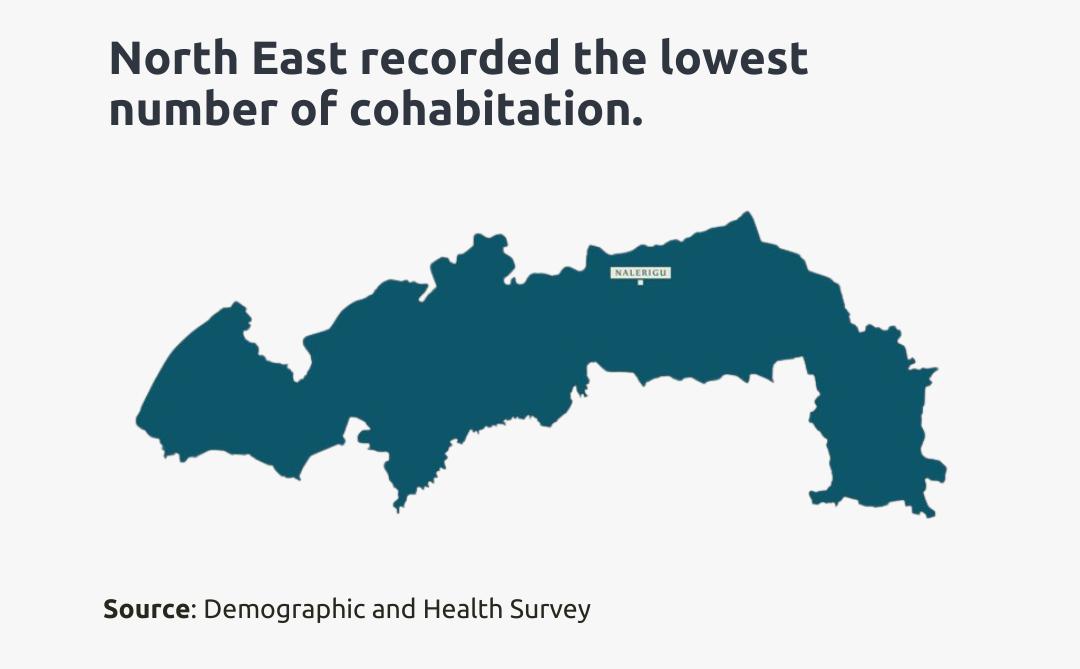
North East recorded the lowest number of cohabitation, with about 9,239 people cohabiting.
42. 4.1% of women aged 15-19 years cohabit. (DHS, 2022)
A report on the Demographic and Health Survey in 2022 indicated that 4.1% of women between the ages of 15 and 19 cohabit, compared to 0.7% of men.
43. 18.9% of women aged 20-24 years cohabit. (DHS, 2022)
A report on the Demographic and Health Survey in 2022 indicated that 18.9% of women between the ages of 20 and 24 cohabit, compared to 6.1% of men.
44. 20.8% of women aged 25-29 years cohabit. (DHS, 2022)
A report on the Demographic and Health Survey in 2022 indicated that 20.8% of women between the ages of 25 and 29 cohabit, compared to 12.4% of men.
45. 13.4% of men aged 30-34 years cohabit. (DHS, 2022)
A report on the Demographic and Health Survey in 2022 indicated that 13.4% of men between the ages of 30 and 34 cohabit, compared to 18.0% of women.
46. 9.9% of men aged 35-39 years cohabit. (DHS, 2022)
A report on the Demographic and Health Survey in 2022 indicated that 9.9% of men between the ages of 35 and 39 cohabit, compared to 15.7% of women.
Marriage rate in Ghana
47. The total number of people who are married in Ghana is 8,366,466. (Ghana Statistical Service)
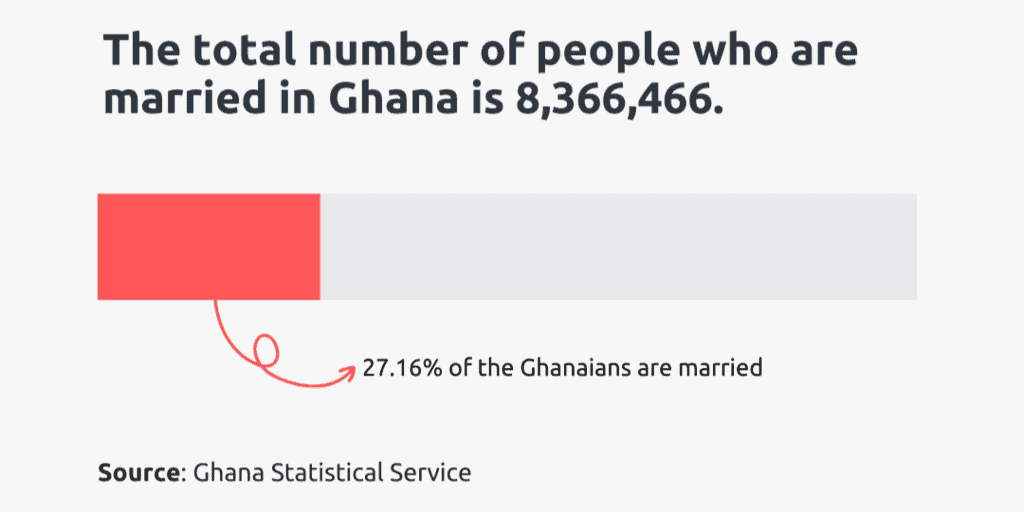
The Ghana Statistical Service’s 2021 Population and Housing Census report indicates that 8,366,466 people are married, representing 27.16% of the population.
48. Only 1,617,844 marriages are registered in Ghana. (Ghana Statistical Service)
The report by the Ghana Statistical Service on the 2021 Population and Housing Census indicates that only 1,617,844 people, representing 5.25% of married people, have their marriages registered.
49. 80.8% of marriages are yet to be registered in Ghana. (Ghana Statistical Service)

According to the 2021 census by the Ghana Statistical Service, 80.8% of couples still need to register their marriages in Ghana.
50. More than 2,000 marriages were registered in 2023. (GhanaWeb)
In 2023, the Registrar-General’s Department in Ghana registered 2,103 internal and external marriages.
51. More marriages are registered in urban areas than in rural areas. (Ghana Statistical Service)
In 2021, 27.3% of marriages were registered in urban areas, a significantly higher rate than the 9.3% recorded in rural areas.
52. The northern region of Ghana recorded the highest number of unregistered marriages in Ghana. (Ghana Statistical Service)
Unregistered marriages in the Northern, Savannah, and North East regions are reported to be 97.1%, 96.1%, and 95.7%, respectively.
53. 2 out of 10 married men had two or more sexual partners in 2022. (DHS, 2022)
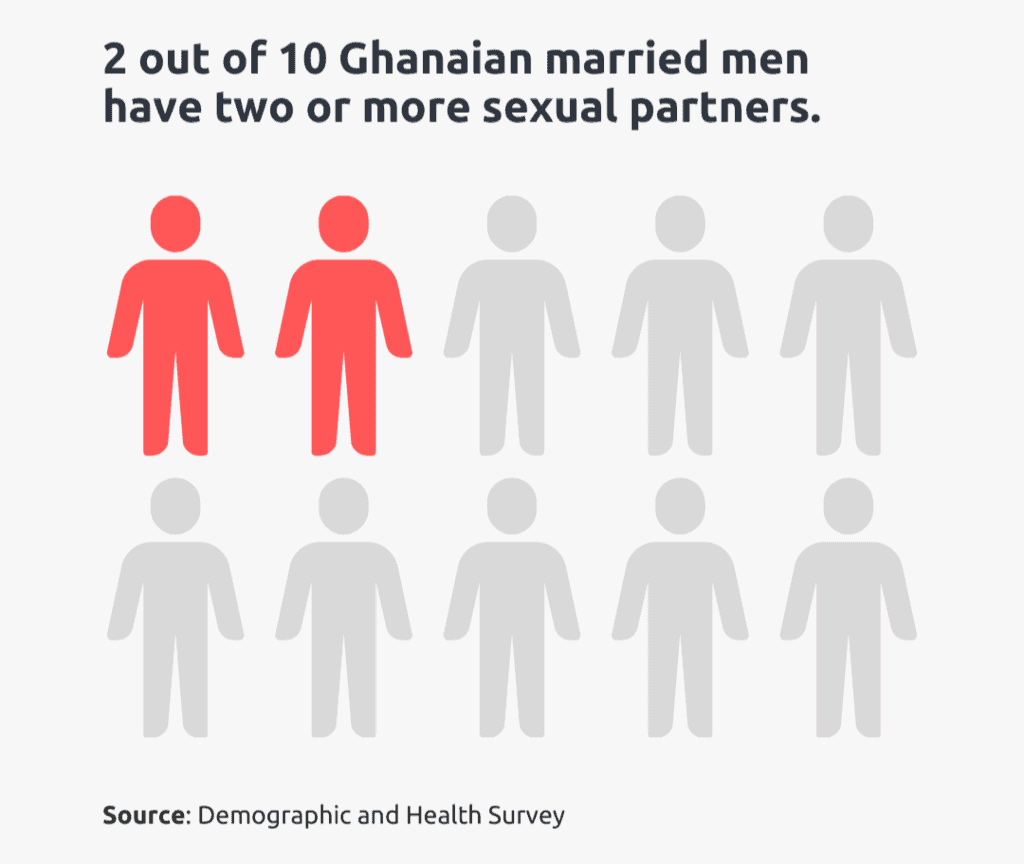
Out of the 7,044 men between the ages of 15 years and 49 years interviewed, the survey revealed that approximately 1,057 (15%) of those men had two or more sexual partners.
54. There is a decline in the number of women who are formally married. (DHS, 2022)
According to the Ghana Statistical Service (GSS), the number of women whose marriages are registered has declined from 65% in 1988 to 40% in 2022.
55. 7,875,880 persons who have never been married. (Ghana Statistical Service)
According to the 2021 Population and Housing Census (PHC) conducted by the Ghana Statistical Service, 7,875,880 people in Ghana have never married.
56. 15% of married women are in polygamous marriages. (Ghana Statistical Service)
According to the Ghana Statistical Service(GSS), married women between 15 and 49 report that their husbands will have other wives in 2022.
57. Polygyny marriage union is uncommon among Ghanaian Christian women. (PLOS)
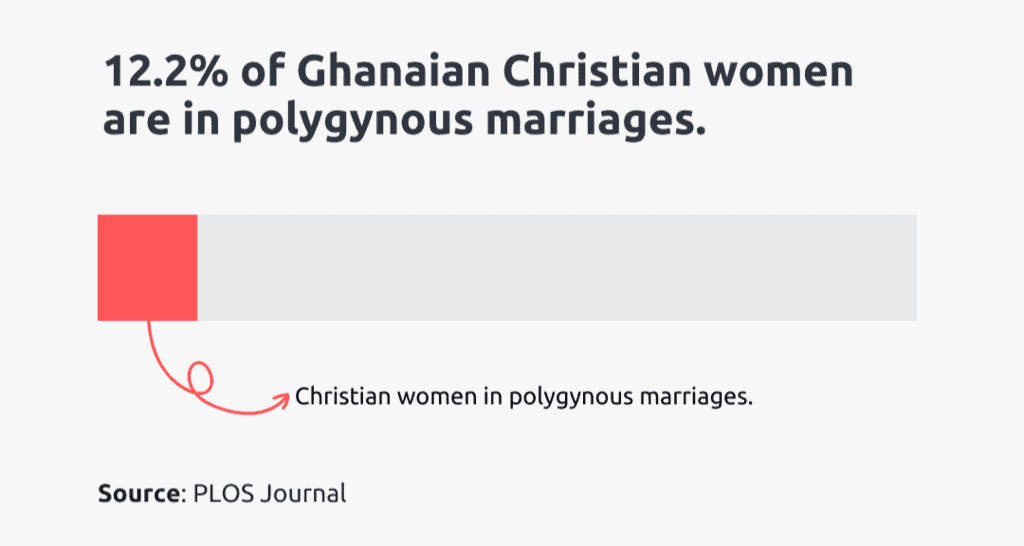
Ghanaian Christian women involved in polygyny marriages was 12.2% in 2023 due to factors such as education, age, and marriage history, among others.
Teenage Pregnancy in Ghana
58. 102,673 teenagers were pregnant in 2022. (Graphic Online)
Ghana Health Service (GHS) data shows that 102,673 teenagers were reported to be pregnant in 2022, an increase from 2021.
59. Savannah regions recorded the highest number of teenage pregnancies. (Ghana Statistical Service)
Savannah region has the highest record of teenage pregnancy among all the regions, with 25.9% in 2022.
60. Greater Accra recorded the lowest number of teenage pregnancies. (Ghana Statistical Service)

Greater Accra has the lowest record of teenage pregnancy among all the regions, with 6% in 2022.
61. Teenage pregnancy is more common in teenagers with no education. (DHS, 2022)
Teenage pregnancy was recorded at 24.3% of teenagers with no education, while teenagers with secondary education were recorded at 12.5% in 2022.
62. Teenage pregnancy is higher in low-income households. (DHS, 2022)
Ghana Health Service reported in the 2022 Demographic and Health Survey that 23.1% of teenage pregnancies occurred in households in the lowest wealth bracket and 5.7% in the highest wealth bracket households.
63. There was a reduction in teenage pregnancies in the Eastern Region of Ghana in 2023. (Citi Newsroom)
Teenage pregnancies in the Eastern Region of Ghana reduced from 13.1% in 2019 to 5.9% in 2023.
64. 104 teenage pregnancies were recorded in the Wa East District of Ghana in 2023. (GNA)
The Wa East District Director of Health Services reported that Wa East District recorded 104 cases of teenage pregnancy in the first quarter of 2023, which he attributed to child marriage and poverty.
65. Approximately 18.9% of teenage pregnancies were recorded in the Volta Region in the first quarter of 2023. (SAWR)

The Volta Region recorded 18.9% of teenage pregnancies in the first quarter of 2023, which was attributed to poverty and early marriages.
66. The Central Region recorded a reduction in teenage pregnancies. (GBC Online)
The Central Region recorded a 64% decrease in teenage pregnancies, from 13,355 in 2014 to 8,539 in 2023.
67. Komenda Edina Eguafo Abrem municipal records 12.2% of teenage pregnancies. (Graphic Online)
Komenda Edina Eguafo Abrem municipality recorded 496 teenage pregnancies, representing 12.2% of the municipality’s pregnant women.
Early marriage rate in Ghana
68. 79,733 girls in Ghana aged between 12 and 17 are married. (DHS, 2022)
Ghana Statistical Service reported that about 79,733 girls aged between 12 and 17 are married or cohabiting as of 2022.
69. The North East Region recorded the highest number of child marriages in Ghana. (DHS, 2022)
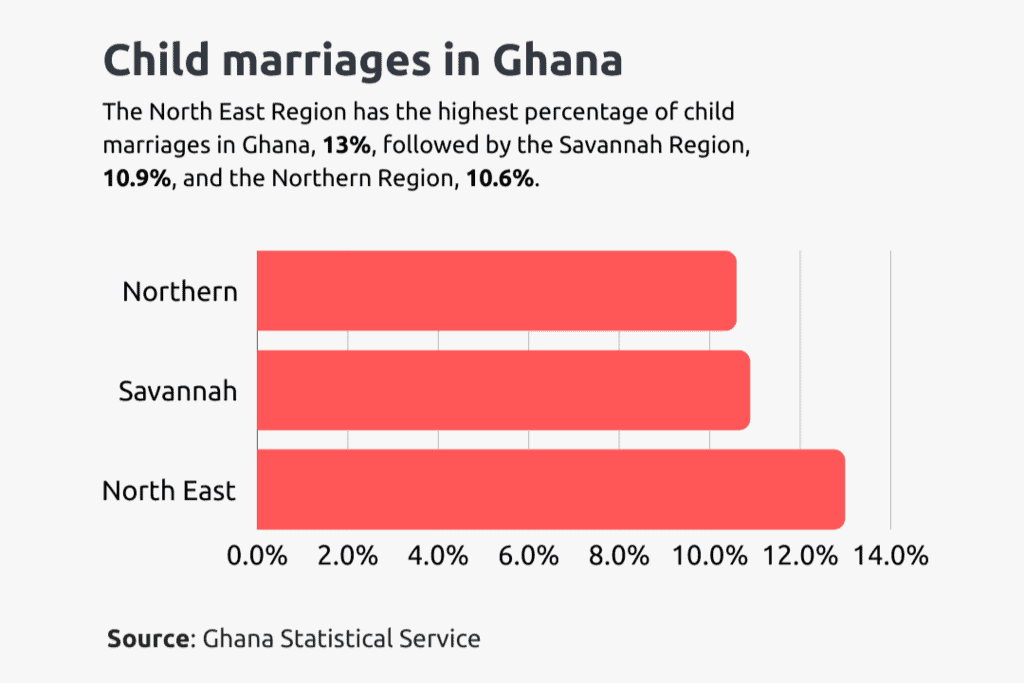
The North East Region recorded the highest rate of early marriage, with 13% in 2022, which was attributed to poverty, cultural beliefs, and illiteracy, among others.
70. The national rate of early marriage is 4%. (GNA, NCBI)
The national rate of early marriage stands at 4%, marking a significant decline from the 35% recorded in the 1990s.
71. 1,014 children are in early marriages in the NKwanta North District in the Oti Region. (Citi Newsroom)
The 2023 Ghana Statistical Service (GSS) report indicated that 1,014 children between the ages of 12 and 17 years have been married in the NKwanta North District in the Oti Region.
72. 43% of boys were in early marriages in the Nkwanta North District. (Citi Newsroom)
The Ghana Statistical Service (GSS) reported that 43% of the 1,014 children in early marriages in 2023 were males, while 57% were females.
73. There are more early marriages in rural areas than in urban areas. (Child Marriage Data)
22.4% of children in rural areas are in early marriages compared to 11.5% in urban areas.
74. More children below the age of 15 who are in primary school got married in Ghana in 2022. (Child Marriage Data)
Children in early marriages below 15 years who are in primary school constituted 8.9% of children in early marriages, while their counterparts with no education constituted 7.4%.
75. About 58 million child marriages are unlikely to happen by 2030. (UNFPA Ghana)
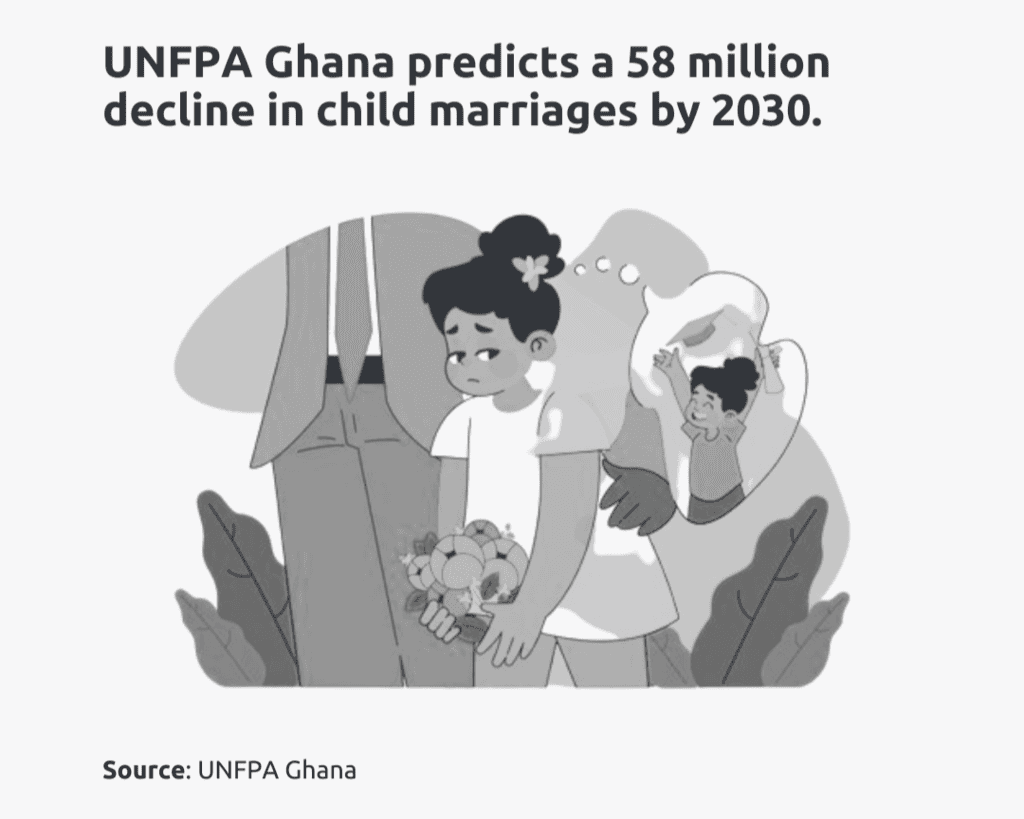
The United Nations Fund for Population Activities (UNFPA) Ghana predicts a 58 million decline in child marriages in Ghana by the year 2030 because of measures put in place like $35 billion in investments to reduce child marriage and better girl child education, among others.
76. The prevalence of early marriage is higher among poor households as of 2022. (Child Marriage Data)
In 2022, the poorest households recorded the highest number of early marriages, 25.5%, while the wealthiest households recorded the lowest, 5.6%.
77. Early marriages are more common among children with no schooling than those with some amount of education in 2022. (Child Marriage Data)
Children with no schooling involved in early marriages are 36.1%, while those with primary education are 35.5%, and those with secondary education or higher recorded the least with 12.2%.
Conclusion
The statistics we’ve examined paint a detailed picture of Ghana’s ongoing social challenges. Addressing these issues requires a collective push from both the government and its citizens.
Let’s contribute to one another’s well-being by doing our part in areas where we can. We welcome your thoughts and further dialogue on these matters in the comment section.
